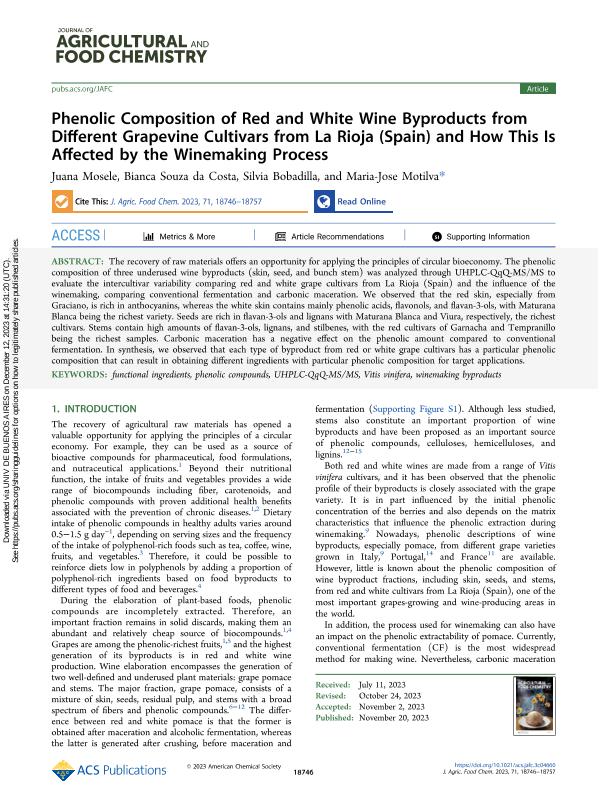Artículo
Phenolic Composition of Red and White Wine Byproducts from Different Grapevine Cultivars from La Rioja (Spain) and How This Is Affected by the Winemaking Process
Fecha de publicación:
11/2023
Editorial:
American Chemical Society
Revista:
Journal of Agricultural and Food Chemistry
ISSN:
0021-8561
Idioma:
Inglés
Tipo de recurso:
Artículo publicado
Clasificación temática:
Resumen
The recovery of raw materials offers an opportunity for applying the principles of circular bioeconomy. The phenolic composition of three underused wine byproducts (skin, seed, and bunch stem) was analyzed through UHPLC-QqQ-MS/MS to evaluate the intercultivar variability comparing red and white grape cultivars from La Rioja (Spain) and the influence of the winemaking, comparing conventional fermentation and carbonic maceration. We observed that the red skin, especially from Graciano, is rich in anthocyanins, whereas the white skin contains mainly phenolic acids, flavonols, and flavan-3-ols, with Maturana Blanca being the richest variety. Seeds are rich in flavan-3-ols and lignans with Maturana Blanca and Viura, respectively, the richest cultivars. Stems contain high amounts of flavan-3-ols, lignans, and stilbenes, with the red cultivars of Garnacha and Tempranillo being the richest samples. Carbonic maceration has a negative effect on the phenolic amount compared to conventional fermentation. In synthesis, we observed that each type of byproduct from red or white grape cultivars has a particular phenolic composition that can result in obtaining different ingredients with particular phenolic composition for target applications.
Archivos asociados
Licencia
Identificadores
Colecciones
Articulos(IBIMOL)
Articulos de INSTITUTO DE BIOQUIMICA Y MEDICINA MOLECULAR
Articulos de INSTITUTO DE BIOQUIMICA Y MEDICINA MOLECULAR
Citación
Mosse, Juana Inés; Souza da Costa, Bianca; Bobadilla, Silvia; Motilva, Maria Jose; Phenolic Composition of Red and White Wine Byproducts from Different Grapevine Cultivars from La Rioja (Spain) and How This Is Affected by the Winemaking Process; American Chemical Society; Journal of Agricultural and Food Chemistry; 71; 48; 11-2023; 18746-18757
Compartir
Altmétricas




